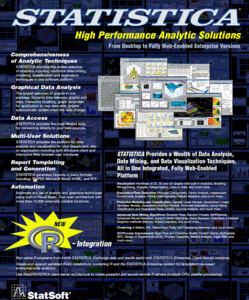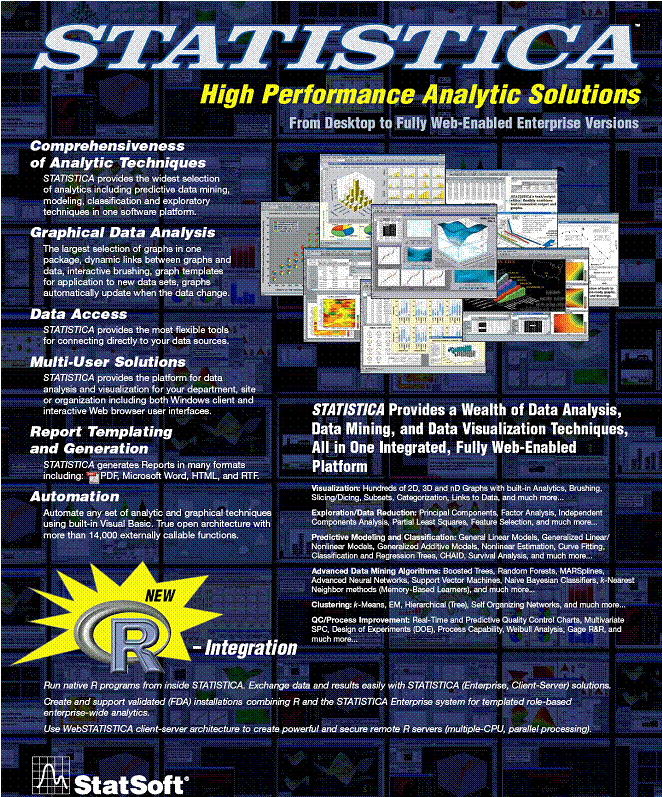StatSoft Statistica vol.8.0.550 | 812 Mb in 9 Parts
Very Rare
Very Rare
Descriptive Statistics and Graphs. The program will compute practically all common, general-purpose descriptive statistics including medians, modes, quartiles, user-specified percentiles, average and standard deviations, quartile ranges, confidence limits for the mean, skewness and kurtosis (with their respective standard errors), harmonic means, geometric means, as well as many specialized descriptive statistics and diagnostics, either for all cases or broken down by one or more categorical (grouping) variables. As with all modules of STATISTICA, a wide variety of graphs will aid exploratory analyses, e.g., various types of box-and-whisker plots, histograms, bivariate distribution (3D or categorized) histograms, 2D and 3D scatterplots with marked subsets, normal, half-normal, detrended probability plots, Q-Q plots, P-P plots, etc. A selection of tests is available for fitting the normal distribution to the data (via the Kolmogorov-Smirnov, Lilliefors, and Shapiro-Wilks' tests; facilities for fitting a wide variety of other distributions are also available).
By-Group Analyses (Breakdowns). Practically all descriptive statistics as well as summary graphs can be computed for data that are categorized (broken down) by one or more grouping variables. For example, with just a few mouse clicks the user can break down the data by Gender and Age and review categorized histograms, box-and-whisker plots, normal probability plots, scatterplots, etc. If more than two categorical variables are chosen, cascades of the respective graphs can be automatically produced. Options to categorize by continuous variables are provided, e.g., you can request that a variable be split into a requested number of intervals, or use the on-line recode facility to custom-define the way in which the variable will be recoded (categorization options of practically unlimited complexity can be specified at any point and they can reference relations involving all variables in the dataset). In addition, a specialized hierarchical breakdown procedure is provided that allows the user to categorize the data by up to six categorical variables, and compute a variety of categorized graphs, descriptive statistics, and correlation matrices for subgroups (the user can interactively request to ignore some factors in the complete breakdown table, and examine statistics for any marginal tables). Numerous formatting and labeling options allow the user to produce publication-quality tables and reports with long labels and descriptions of variables. Note that extremely large analysis designs can be specified in the breakdown procedure (e.g., 100,000 groups for a single categorization variable), and results include all relevant ANOVA statistics (including the complete ANOVA table, tests of assumptions such as the Levene and Brown-Forsythe tests for homogeneity of variance, a selection of seven post-hoc tests, etc.). As in all other modules of STATISTICA, extended precision calculations (the "quadruple" precision, where applicable) are used to provide an unmatched level of accuracy (see the section on Precision). Because of the interactive nature of the program, exploration of data is very easy. For example, exploratory graphs can be produced directly from all results Spreadsheets by pointing with the mouse to specific cells or ranges of cells. Cascades of even complex (e.g., multiple categorized) graphs can be produced with a single-click of the mouse and reviewed in a slide-show manner. In addition to numerous predefined statistical graphs, countless graphical visualizations of raw data, summary statistics, relations between statistics, as well as all breakdowns and categorizations can be custom-defined by the user via straightforward point-and-click facilities designed to reduce the necessary number of mouse clicks. All exploratory graphical techniques (described in the section on Graphics) are integrated with statistics to facilitate graphical data analyses (e.g., via interactive outlier removal, subset selections, smoothing, function fitting, extensive brushing options allowing the user to easily identify and/or extract the selected data, etc.).
CORRELATIONS. A comprehensive set of options allows for the exploration of correlations and partial correlations between variables. First, practically all common measures of association can be computed, including Pearson r, Spearman rank order R, Kendall tau (b, c), Gamma, tetrachoric r, Phi, Cramer V, contingency coefficient C, Sommer's D, uncertainty coefficients, part and partial correlations, autocorrelations, various distance measures, etc. (nonlinear regressions, regressions for censored data and other specialized measures of correlations are available in Nonlinear Estimation, Survival Analysis, and other modules offered in STATISTICA Advanced Linear/Non-Linear Models). Correlation matrices can be computed using casewise (listwise) or pairwise deletion of missing data, or mean substitution. As in all other modules of STATISTICA, extended precision calculations (the "quadruple" precision, where applicable) are used to yield an unmatched level of accuracy (see the section on Precision). Like all other results in STATISTICA, correlation matrices are displayed in Spreadsheets offering various formatting options (see below) and extensive facilities to visualize numerical results; the user can "point to" a particular correlation in the Spreadsheet and choose to display a variety of "graphical summaries" of the coefficient (e.g., scatterplots with confidence intervals, various 3D bivariate distribution histograms, probability plots, etc.).
etc.etc.etc.
ALL TOOLS WORKING 100% - CRACK with instructions INSIDE - READ IT FIRST !!!
DATA MINING TOOL WORKING 100%
http://rapidshare.com/files/156352963/STat_8.0.550.part01.rar
http://rapidshare.com/files/156352964/STat_8.0.550.part02.rar
http://rapidshare.com/files/156650173/STat_8.0.550.part03.rar
http://rapidshare.com/files/156650176/STat_8.0.550.part04.rar
http://rapidshare.com/files/156686857/STat_8.0.550.part05.rar
http://rapidshare.com/files/156686859/STat_8.0.550.part06.rar
http://rapidshare.com/files/156770948/STat_8.0.550.part07.rar
http://rapidshare.com/files/156770951/STat_8.0.550.part08.rar
http://rapidshare.com/files/156951322/STat_8.0.550.part09.rar
DATA MINING TOOL WORKING 100%
http://rapidshare.com/files/156352963/STat_8.0.550.part01.rar
http://rapidshare.com/files/156352964/STat_8.0.550.part02.rar
http://rapidshare.com/files/156650173/STat_8.0.550.part03.rar
http://rapidshare.com/files/156650176/STat_8.0.550.part04.rar
http://rapidshare.com/files/156686857/STat_8.0.550.part05.rar
http://rapidshare.com/files/156686859/STat_8.0.550.part06.rar
http://rapidshare.com/files/156770948/STat_8.0.550.part07.rar
http://rapidshare.com/files/156770951/STat_8.0.550.part08.rar
http://rapidshare.com/files/156951322/STat_8.0.550.part09.rar



